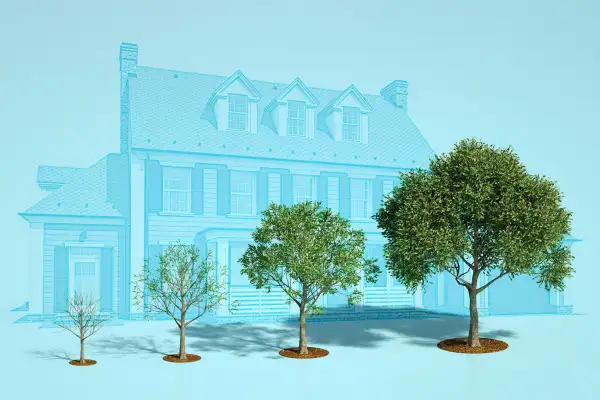Want to Boost the Value of Your Home? Plant a Tree — Right Now

If you’re a homeowner who missed the boat on the red-hot real estate market, selling your property at a premium might be easier than you think — at least if it has some trees.
It sounds silly, but real estate pros say buyers are drawn toward treed lawns for both aesthetic and economical reasons. They’re so drawn to them, in fact, that they’re willing to pay a premium.
Data backs this up, too. Numerous studies show that homes with trees have anywhere from 3.5% to 15% more value than those without. If you’re selling the median-priced home in the U.S. — currently $407,600 — that means anywhere from $14,000 to $61,000 more in profit.
“One of the very best things you can do to increase the value and estate-like quality of your home is to surround it with beautiful trees and foliage,” says Suzi Dailey, a real estate agent at Realty ONE Group West in Laguna Niguel, California. “It will definitely increase the dollar value of your house — as well as the community you live in.”
How much is a tree worth?
The exact premium a tree can provide depends on a lot of factors, like where it’s planted, the look and condition of the tree and how mature it is.
Methods to assess a particular tree’s value do exist, though these are typically used for insurance and legal purposes (when a tree has been damaged, for example) and not for pricing a house. Dubbed “tree appraisals,” these use various formulas to assign a monetary price to each tree based on its size, condition and species.
According to one method from the Purdue University Department of Horticulture, white firs, Colorado blue spruces, American beeches and sugar maples are among the highest-valued trees. Using the Purdue formula, a sugar maple with a 10-inch trunk diameter in good health is valued at over $3,500.
Mark Duntemann, owner of Natural Path Forestry, says he recently appraised a swamp white oak for a local homeowner’s association. After taking into account the cost of similar trees and the current condition of the tree in question, he determined it was worth just over $79,000.
To be clear: If that specific white oak were on your property, it wouldn’t mean you could sell the house for $79K more (if it did, I’d be at my local nursery right this very second.) But, “If a third party were to kill the tree, the HOA could seek this number in damages,” Duntemann says.
For homeowners, the real value of a beautiful, well-maintained tree comes from how appealing it makes the property to potential buyers.
Mark Walser, president of Incenter Appraisal Management, used his own experience as an example. When he bought his Charlotte, N.C., home a few years ago, its abundance of mature trees was a big factor. He was even willing to pay more than what other untreed homes were going for in the area.
Did he pay the exact amount those trees were “worth,” though? Likely not.
“Our lot has three mature Japanese dwarf maples ... valued at over $8,000 to $15,000 apiece," he says. "If our seller had stated they wanted a $25,000 premium for the Japanese maples, I would not have paid it — and it’s highly unlikely an appraiser would have included it in their valuation.”
Why trees are appealing
Treed homes are clearly in demand. But why?
Real estate pros say it depends on the buyer. For some, it’s simply aesthetic. Trees — particularly mature, shady ones and those with flowers and fruit — just look nice.
For more eco-conscious homebuyers, trees offer even more benefits. They improve air quality, reduce water runoff and trap carbon dioxide, which contributes to climate change.
In hotter parts of the U.S., they can also reduce the energy output of a home. According to the U.S. Department of Agriculture, a healthy shade tree offers a housewide cooling effect equal to 10 room-sized air conditioners running 20 hours a day.
That comes with huge cost savings: The Center for Urban Forest Research found that just one tree planted on the west side of a home can reduce its energy bills by 3% in five years and 12% by year 15.
It's harder to assign a dollar value to the trees on your property compared to, say, a kitchen remodel, it's clear they make your home more attractive to potential buyers. Anecdotally, real estate agents say homes with trees sell faster (as much as three times faster, by some accounts.)
“Well-placed trees and landscaping will frame the architecture and allow people to see themselves using the outdoor spaces,” says Casey Case, a landscape architect and president of Gates + Associates in Walnut Creek, California.
Large shade trees, in particular, “have an oomph,” she says. “A presence that serves as a pleasant backdrop for … picnics, swings and leisure time.”
When trees can hurt
In some cases, having a tree on your property can actually hurt its resell value. Poorly cared-for trees are one such detriment — especially if they are dying, unhealthy or otherwise at risk of toppling over.
“A tree that has been poorly selected, poorly sited on the property or not maintained well can certainly be a negative feature,” Duntemann says. “Poor structure, significant deadwood, branches touching the house and noxious fruit are a few examples.”
Trees that block views or take a lot of care can also make a home less marketable. The same goes for trees with root structures that like to invade underground water and pipelines (ahem, weeping willow.)
“Some well-placed, smaller trees such as a cherry can be really beautiful in a yard and stay small enough to easily manage,” says Alex Capozzolo, co-founder of Brotherly Love Real Estate in Philadelphia. “There are others, like pepper trees, that drop a lot of sap, make a mess and when too close to the house can damage the foundation or roof or both. The maintenance and damage can be a huge hassle.”
All of these things turn buyers off. It can cost anywhere from $200 to $2,000 to remove a single tree, and removing a handful of them? That can easily run into the tens of thousands.
It’s worth knowing that some cities also have laws regarding tree removal, which could limit your options down the road. In Aspen, Col., where trees are a huge part of the area’s appeal, you need a special permit — and a home visit from the city’s forester — to legally get rid of the trees on your property. Aspen homeowners are also responsible for “mitigating” the loss by planting new trees of the same value as the old ones or by paying the city directly.
Gary Feldman of Aspen Snowmass Sotheby’s International Realty has been selling Aspen real estate for nearly 40 years and says he’s seen the red tape in action.
“I have witnessed homeowners who planted saplings not realizing they would one day grow to obscure their million-dollar views,” Feldman says. “This resulted in a bureaucracy that wouldn’t allow them to remove the trees.”
The best trees for your money — and where to plant them
Whether you just moved into a new home or have been at the same place for years, planting trees for profitability takes some careful consideration.
To start, find out what trees are native to your area. If you’re in the Midwest, you might opt for a bur oak. In the Northeast, a gray birch could be a good choice. You can check with a local arborist or landscaping company to get an idea of what trees are native to your region. Tools like the Arbor Day Foundation’s Tree Wizard can also help.
Choosing native trees can extend their lifespan and make them easier to care for. They also require fewer resources. That’s partially why Taylor Morrison — one of the nation’s biggest home builders — uses 100% native plants in its community parks and green spaces.
“Native plants have evolved in your region over the course of hundreds of thousands of years,” says Chad Eby, Taylor Morrison’s corporate director of sustainability. “These plants thrive in their local soils, rainfall levels, weather and climate conditions, so they require less maintenance and have a more positive environmental impact than non-native species.”
Once you’ve settled on a tree type, choose the proper placement. Large trees in a prominent front-yard position will likely fetch the highest premium, according to Scott Maco, director of research and development at nationwide tree care provider The Davey Tree Expert Company. Trees that offer shade on back patios or act as a privacy screen are valuable too, and energy-saving capabilities should also factor in.
“Large deciduous trees on the east and west side of buildings will provide the most summer energy savings,” Maco says, since those trees — which include oaks and maples — create a canopy of shade in the spring and drop their leaves when the weather dips. On the other hand, “Strategically placed evergreen windbreak trees will provide the most savings in the winter,” he says.
Finally — and most importantly, according to the pros — read up on what care and maintenance are required to keep your tree in good shape. At the very least, that means watering it regularly, pruning dead and diseased limbs and mulching.
“The appeal of a beautiful, grand and healthy tree is always a welcome sight at any home,” says Kirstin McQuillan, associate broker at Century 21 Nason Realty in Winslow, Maine.
But a dead or diseased tree? That won’t do you any favors.
“A potential buyer can think ‘Wow, look at that tree. I can see my kids building a treehouse in that tree,’” McQuillan says. “Or, ‘Wow, look at that tree. It’s so close to the house and looks half-dead. How much will that cost to take down?”
More from Money:
The 10 Cities Where the Housing Market Is Cooling the Fastest
Got a Backyard? You Can Make Thousands a Month by Letting Dogs Come Play in It


